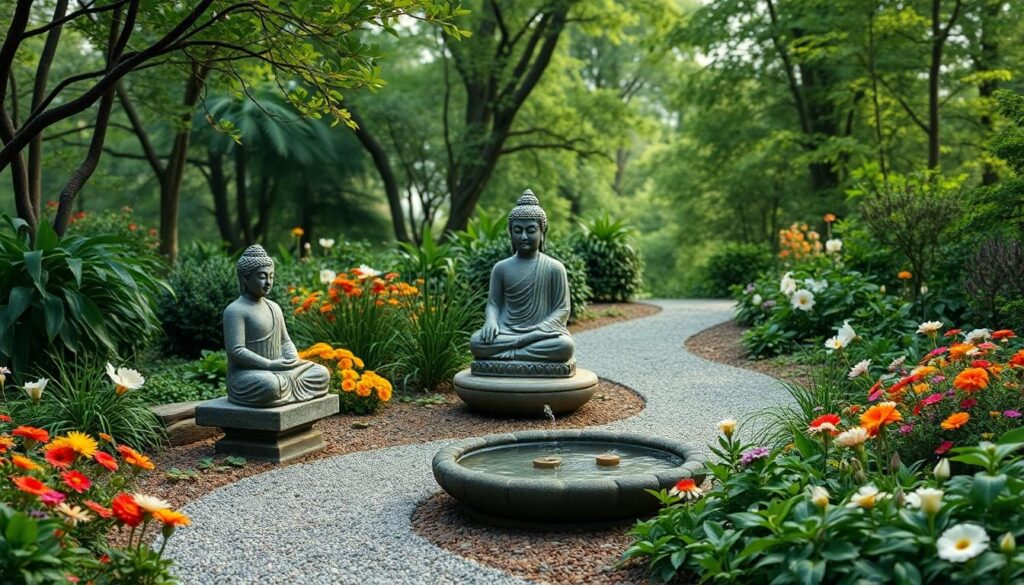Creating a spiritual garden offers a unique way to blend nature with inner peace—a sanctuary where we can reconnect with ourselves and the universe. These sacred spaces have been cherished across cultures for centuries, providing solace and inspiration through thoughtful design elements.
We’ve gathered the most groundbreaking spiritual garden ideas to help you create your own personal retreat. Whether you’re drawn to meditation spaces adorned with Buddha statues, crystal gardens that harness natural energy, or labyrinths that guide your contemplative journey—these designs do more than beautify your outdoor space. They create meaningful environments where spiritual practice and nature’s beauty merge perfectly.
Creating a Sacred Space: How to Design Your Spiritual Garden
1. Choose the Right Location
Finding the perfect spot for your spiritual garden starts with identifying an area that naturally feels peaceful. Look for a location that receives adequate sunlight yet offers some shade throughout the day. Privacy is essential for creating a truly sacred space, so consider placing your garden in a secluded corner of your yard away from neighborhood noise and activity. The energy of the space matters significantly—some people use feng shui principles to determine the optimal positioning. Pay attention to how different areas of your property make you feel, and trust your intuition when selecting the perfect spot.
2. Plan the Layout Thoughtfully
Designing your garden’s layout requires balancing aesthetics with functionality and spiritual purpose. Start by sketching a simple map of your intended space, marking areas for meditation, pathways, water features, and plant groupings. Circular designs often represent wholeness and infinity, while straight paths can symbolize direct spiritual journeys. Create natural divisions using plants of varying heights or decorative screens that separate different energy zones. The flow of movement through your garden should feel intuitive and peaceful, guiding visitors through a meaningful spiritual experience.
3. Select Plants with Spiritual Significance
Plants form the living foundation of your spiritual garden and should be chosen with intention. Lavender promotes tranquility and healing, while rosemary has been used for purification for centuries. Sacred lotus symbolizes enlightenment in many Eastern traditions, making it perfect for water features. Consider incorporating trees like oak for strength and wisdom or willow for intuition and inner vision. Native plants will thrive with minimal care while attracting beneficial wildlife that adds vitality to your space. Arrange plants according to their symbolic meanings, creating clusters that represent different aspects of your spiritual practice.
4. Incorporate Meaningful Elements
Adding spiritual elements transforms an ordinary garden into a sacred sanctuary. Consider installing a small Buddha statue, angel figures, or symbols from your personal faith tradition as focal points. Crystal gardens catch and refract light while amplifying energetic properties—place rose quartz for love or amethyst for spiritual awareness. Wind chimes, singing bowls, or bells add auditory elements that clear negative energy and mark ceremonial moments. Water features like small fountains or bird baths symbolize purification and renewal while providing soothing sounds. Personal mementos or objects from important life experiences can also be thoughtfully integrated to deepen your connection to the space.
5. Create Designated Meditation Areas
Establishing a dedicated meditation space serves as the heart of your spiritual garden. Install comfortable seating like a weather-resistant bench, meditation cushions, or even a hammock where you can sit in contemplation. Position this area to capture beautiful views or face directions with personal significance. Provide shade with pergolas, canvas coverings, or strategically planted trees to make the space usable throughout the day. The meditation area should feel naturally set apart, perhaps slightly elevated or defined by a circle of stones or special plants. Consider adding small tables or platforms for holding spiritual texts, journals, or ritual items.
6. Design Mindful Pathways
Pathways guide both physical movement and spiritual journeys through your garden sanctuary. Winding paths encourage mindfulness and slowing down, while labyrinths provide walking meditation experiences that mirror inward spiritual journeys. Use materials that feel good underfoot and complement your garden’s theme—smooth river stones, natural wood chips, or brick pavers all offer different sensory experiences. Borders of fragrant herbs like thyme release aromatic oils when brushed against, adding another sensory dimension to garden walks. Design paths that lead to special destinations or viewpoints that inspire contemplation and wonder.
7. Consider Sacred Geometry
Incorporating sacred geometry patterns adds profound symbolic meaning to your spiritual garden design. The Flower of Life pattern can be recreated with circular plantings or paving stones, representing the interconnected nature of all creation. Spirals, found throughout nature, symbolize growth and evolution—consider spiral herb gardens or pathways that curl inward. Mandalas can be created with colorful flowering plants arranged in concentric circles, offering beautiful meditation focal points. Even simple symmetrical designs reflect balance and harmony, fundamental principles in many spiritual traditions. These geometric patterns can be subtle or prominent depending on your garden’s overall aesthetic.
8. Plan for Privacy and Boundaries
Creating boundaries helps define your sacred space and protects its special energy. Living fences of tall ornamental grasses, bamboo, or hedges provide natural screens while adding beauty and movement. Trellises covered with climbing roses or morning glories create gorgeous vertical boundaries. Traditional fencing can be transformed into spiritual statements with prayer flags, meaningful symbols, or artistic elements. The transition between the outside industry and your sanctuary should feel intentional—consider creating an entrance archway or gate that helps you mentally shift into a more contemplative state. Boundaries also help maintain the garden’s energy by minimizing external distractions.
9. Include Elements of the Four Elements
Balancing the four elements—earth, air, fire, and water—creates harmony and wholeness in your spiritual garden. Earth energy comes naturally through soil and plants but can be enhanced with stones, crystals, or terracotta features. Wind chimes, prayer flags, or tall grasses that sway in the breeze represent the air element. Fire elements might include a small fire pit, candle nooks, or red and orange flowering plants. Water features like fountains, bird baths, or a small pond bring the calming presence of water. Mindfully placing these elemental representations throughout your garden creates balance and acknowledges the fundamental forces that sustain all life.
10. Maintain Your Sacred Space
Caring for your spiritual garden becomes a spiritual practice itself when approached mindfully. Set aside regular times for garden maintenance, treating these sessions as moving meditation rather than chores. Seasonal rituals like spring planting or fall cleanup can mark important transitions in your spiritual calendar. Keep garden tools organized and treated respectfully, acknowledging their role in helping maintain your sacred space. Consider blessing new plants before adding them to your garden, and express gratitude when harvesting herbs or flowers. The ongoing relationship with your garden becomes as meaningful as its initial creation, deepening your spiritual connection over time.
Incorporating Meditation Areas in Your Spiritual Garden
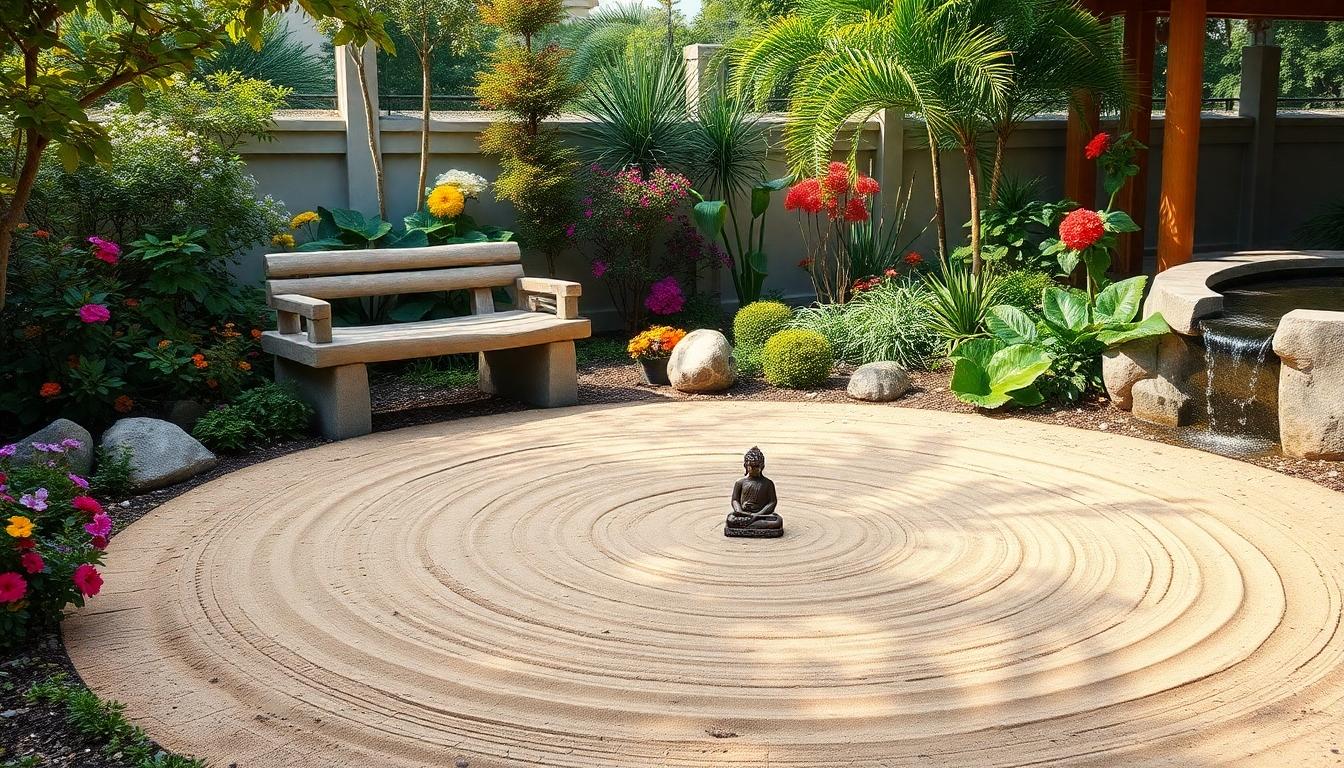
Meditation areas serve as the heart of any spiritual garden, offering dedicated spaces for reflection and mindfulness. Designating quiet corners with comfortable seating and natural elements creates an ideal environment for connecting with your inner self and the surrounding natural industry.
Stone Meditation Benches and Seats
Natural stone benches provide the perfect foundation for meditation spaces in spiritual gardens. Durable materials like slate or sandstone blend seamlessly with the environment while offering practical seating that withstands various weather conditions. Position these stone elements near water features to enhance their calming effect through gentle sounds of flowing water. Flat rocks can serve as alternative seating options that maintain an organic aesthetic while requiring minimal installation. Strategic placement under shade trees or beside fragrant flowering plants maximizes comfort during meditation sessions. The natural coolness of stone also offers a grounding connection to earth energy, reinforcing the spiritual purpose of your garden retreat.
Creating Zen-Inspired Meditation Circles
Circular designs in meditation spaces symbolize wholeness and infinity in spiritual practices. Use raked sand or fine gravel patterns to create simple yet profound Zen-inspired areas that promote mindfulness through their visual simplicity. Low stone walls can define these circular spaces while providing additional seating options for group meditation sessions. Add carefully selected focal points such as Buddha statues, singing bowls, or candles to center attention and encourage deeper contemplation. Wind chimes positioned nearby introduce gentle sound elements that signal transitions in meditation practices. The minimalist aesthetic of these meditation circles creates contrast with more lush planted areas, allowing the mind to find clarity through visual simplicity. Incorporate personal mementos or symbolic items that hold special meaning to enhance your connection to the space during reflection times.
Essential Elements for a Healing Spiritual Garden
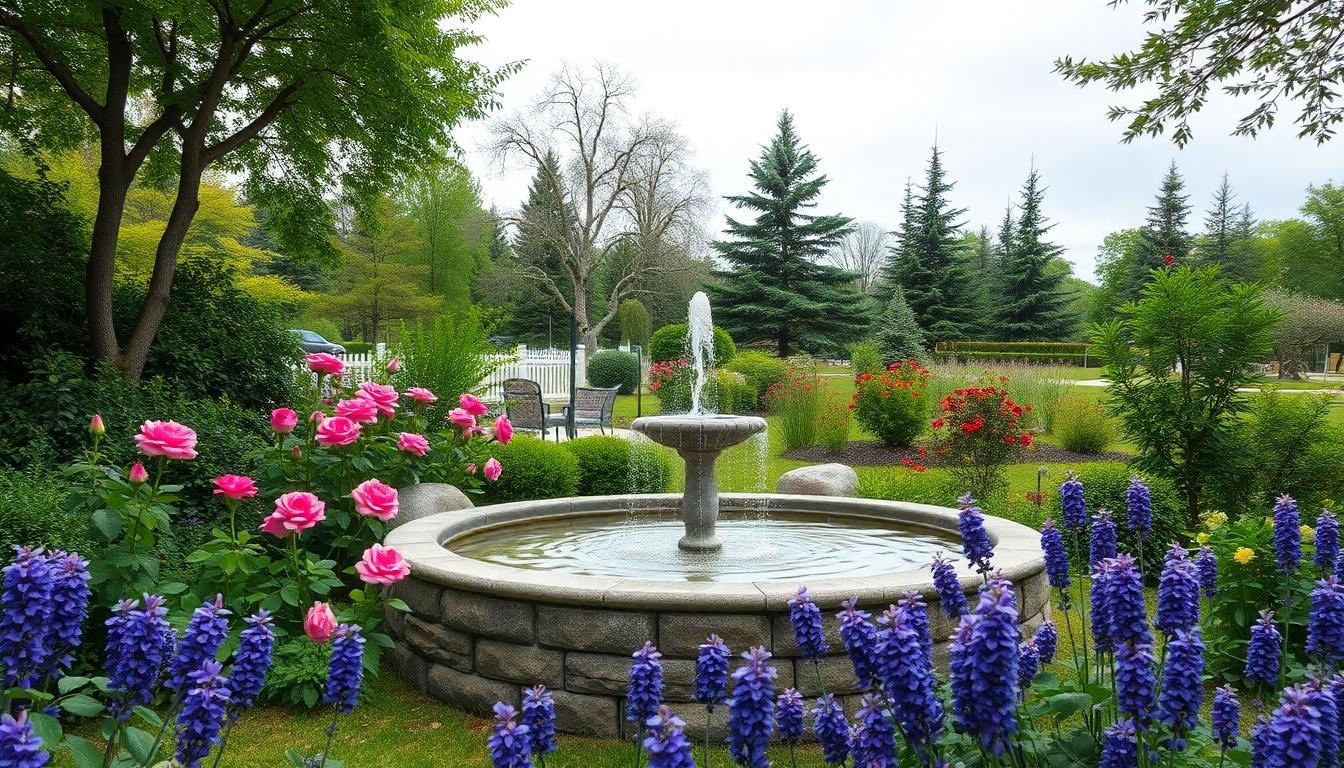
A truly healing spiritual garden combines natural elements in harmonious arrangements that invite contemplation and peace. The most effective spiritual gardens incorporate several key components that work together to create a space of tranquility and deep connection.
Water Features for Tranquility and Reflection
Water elements serve as powerful focal points in any spiritual garden, creating both visual appeal and calming acoustics. Fountains, reflecting pools, and gentle cascades offer perfect meditation anchors, as the sound of water naturally calms the nervous system and promotes mindfulness. Still water surfaces create opportunities for reflection, both literally and metaphorically, inviting visitors to pause and look inward. Even in smaller spaces, tabletop fountains can transform the atmosphere, bringing the therapeutic properties of flowing water to compact gardens.
Sacred Plants and Their Spiritual Meanings
Plants with spiritual significance form the living heart of a contemplative garden, each species contributing its unique energy and symbolism:
- Herbs provide both practical and spiritual benefits, with chamomile creating an atmosphere of tranquility and sage offering powerful purification properties.
- Roses do more than beautify the space; their fragrance serves as a powerful reminder of love and cherished relationships.
- Lavender brings a sense of peace and emotional balance, making it ideal for areas dedicated to meditation or stress relief.
- Vegetables like kale and tomatoes transform gardening into a spiritual practice, symbolizing gratitude for Earth’s abundant gifts.
- Trees anchor the spiritual garden with their profound symbolism, from birch trees representing renewal to cedars embodying strength and protection.
Native plants enhance ecological harmony while creating deeper connections to your local environment. When selecting plants, consider those with personal resonance, such as species connected to meaningful memories or cultural significance. This personal connection transforms an ordinary garden into a deeply meaningful spiritual sanctuary.
Symbolic Statues and Structures for Your Spiritual Garden
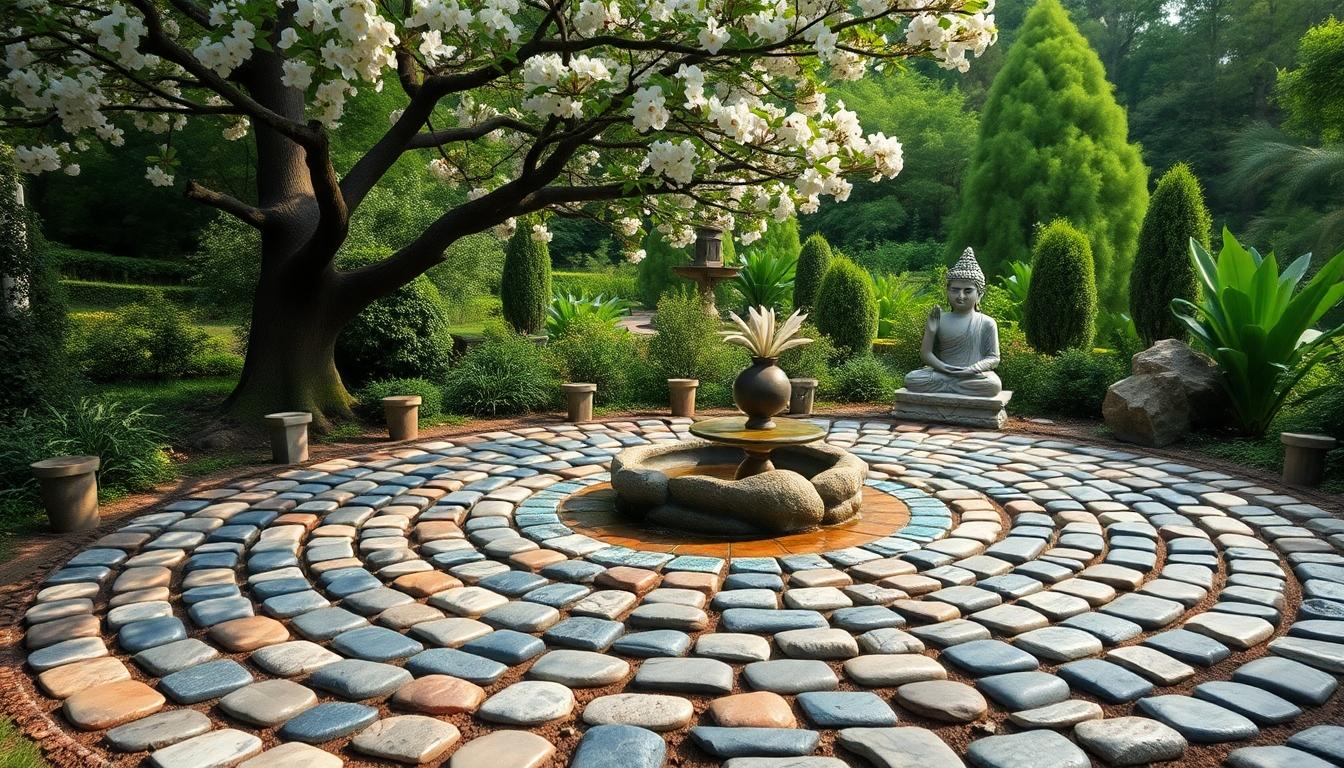
Incorporating symbolic elements into your spiritual garden creates a sacred space that reflects your spiritual journey and enhances meditation experiences. These carefully chosen structures can transform an ordinary garden into a powerful place of reflection and connection with the divine.
Mandalas and Labyrinths
Mandalas and labyrinths serve as powerful symbolic patterns that represent the spiritual journey and inner reflection. Walking a garden labyrinth creates a moving meditation experience, allowing you to journey inward as you follow the path to the center. Garden mandalas can be created using colorful stones, plants arranged in circular patterns, or even painted designs on flat surfaces. These geometric patterns work as focal points that draw the eye and mind into contemplation, making them perfect additions to any spiritual garden seeking to enhance its meditative qualities.
Fountains and Water Features
Water features bring the essential element of renewal and purification to your spiritual garden. Fountains create soothing sounds that mask outside noise and promote deeper states of meditation. Small ponds reflect the sky and surrounding plants, doubling the beauty of your sacred space while symbolizing the mirror of self-reflection. Flowing water represents the constant movement of life and spiritual growth, reminding us that change is the only constant. Adding water elements to your garden creates a multi-sensory experience that calms the mind and opens the heart to spiritual insights.
Sacred Geometry
Sacred geometry incorporates universal mathematical patterns found throughout nature into your garden design. The Flower of Life pattern, with its overlapping circles, can be used in pathway designs or garden layouts to promote harmony and balance. Fibonacci sequences, reflected in spiral patterns, can guide the arrangement of plants or the flow of walking paths. These ancient geometric principles align your garden with universal energetic patterns, creating spaces that feel naturally balanced and harmonious. Incorporating these designs connects your spiritual garden to the mathematical underpinnings of creation itself.
Buddha Statues and Eastern Spiritual Icons
Buddha statues create instant focal points of peace and mindfulness in any spiritual garden. Placing these statues in quiet corners or elevated positions encourages contemplation and reminds visitors of the path to enlightenment. Zen stones, carefully stacked or arranged in meaningful patterns, represent balance and patience while adding a meditative element to the garden industry. Bonsai trees, with their miniature perfection, symbolize harmony between human intervention and natural beauty. These Eastern elements bring ancient wisdom traditions into your garden space, creating areas that naturally invite meditation and spiritual practice.
Angels, Fairies, and Western Spiritual Figures
Angel statues bring protective energy and divine guidance to your spiritual garden, serving as reminders of higher realms and spiritual assistance. These figures work particularly well when placed at garden entrances or elevated on pedestals where they seem to watch over the space. Fairy gardens, with their miniature houses and tiny accessories, create enchanting microcosms that celebrate the magical aspects of nature and invite playfulness into spiritual practice. Goddess sculptures and natural spirit figures connect your garden to ancient Western traditions that honor the divine feminine and the spirits of the land. These Western archetypes add diversity to your garden’s spiritual symbolism while creating conversation pieces that spark deeper discussions about spiritual beliefs.
Designing Prayer Paths and Labyrinths
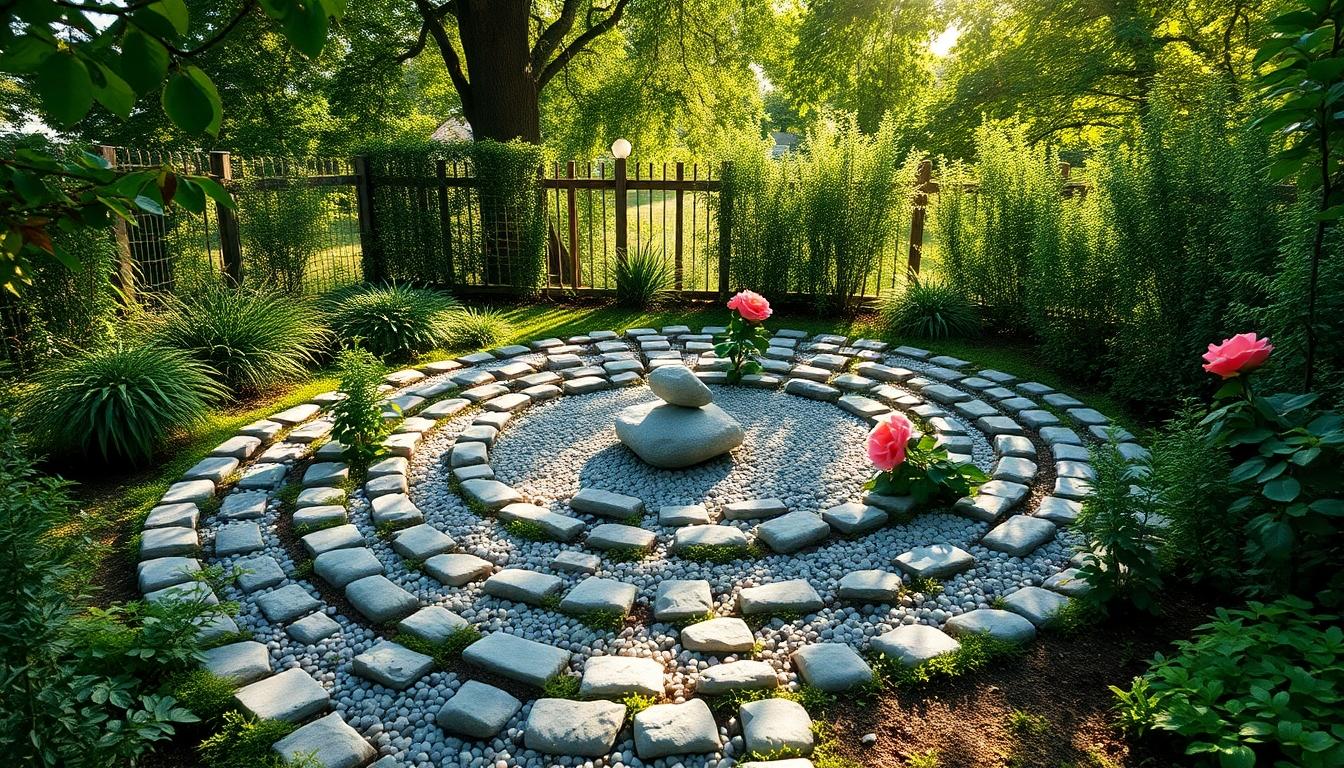
Prayer paths and labyrinths have been used for centuries as tools for spiritual contemplation and mindful walking. These intentional pathways invite us to slow down, connect with our surroundings, and engage in moving meditation.
Walking Meditation Pathways
Walking meditation pathways serve as sacred routes that encourage mindfulness and reflection with each step. These paths invite visitors to practice present moment awareness while moving through the garden space. Curved or winding designs work best as they naturally slow your pace and prevent rushing from one point to another. Materials like gravel, stepping stones, or compacted earth create different sensory experiences underfoot, improving mindfulness during the walk.
Plants alongside these paths should contribute to the contemplative atmosphere – consider aromatic herbs like chamomile that release calming scents when brushed against. The width of your meditation path matters too; narrower paths naturally encourage slower, more deliberate movement. Strategic placement of seating areas along longer paths provides opportunities to pause, rest, and deepen your connection with the surroundings.
Creating a Simple Backyard Labyrinth
Labyrinths differ from mazes as they feature a single, non-branching path leading to the center and back out again, symbolizing life’s journey. Creating a simple backyard labyrinth requires thoughtful planning but doesn’t demand extensive landscaping expertise. Start by selecting a suitable location with enough flat space to accommodate your design – even a small area can host a meaningful labyrinth.
Use stones, gravel, or plants to clearly define the pathways within your labyrinth design. Traditional patterns include the classical seven-circuit design or the simpler three-circuit version for smaller spaces. The path should encourage slow, contemplative walking rather than quick movement through the space. Consider incorporating roses along the borders to remember loved ones, as these flowers carry strong symbolic significance in many spiritual traditions.
Your labyrinth can reflect personal symbolism through carefully chosen elements that resonate with your spiritual practice. The center point typically serves as a special meditation space, often marked with a distinctive stone, statue, or meaningful plant. Many gardeners add vertical elements like wind chimes near their labyrinths, serving as gentle reminders of change and present-moment awareness when activated by the breeze.
Adding Sound Elements for Spiritual Harmony
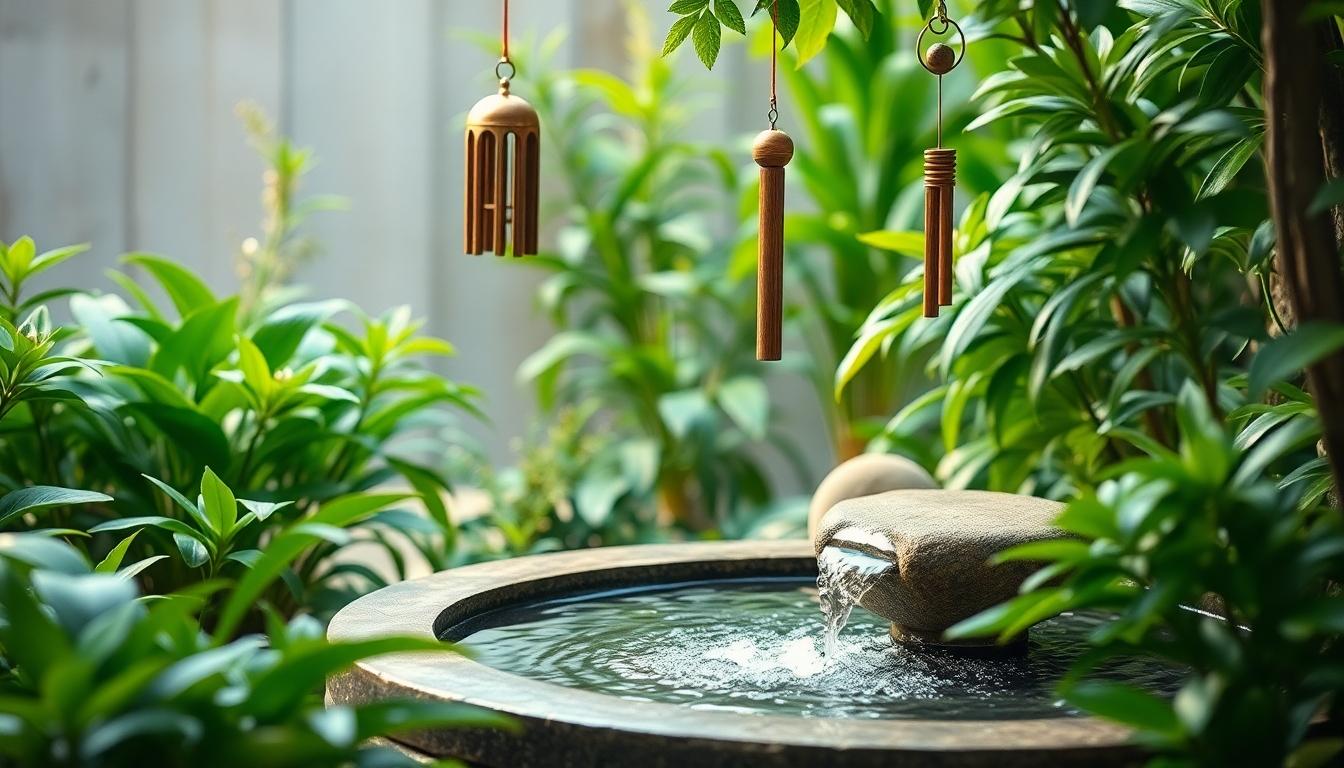
Sound plays a vital role in creating a truly immersive spiritual garden experience. The right acoustic elements can transform your garden into a multisensory sanctuary that deepens meditation and enhances connection with nature.
Wind Chimes and Bells
Wind chimes and bells serve as perfect additions to any spiritual garden, creating gentle, calming sounds that enhance the overall ambiance. Their melodic tones can act as reminders to stay present and mindful while spending time in your garden space. Metal chimes produce crisp, clear sounds that carry well through the air, while wooden chimes offer deeper, more resonant tones. Placing these sound elements at different heights and locations throughout your garden will create varied acoustic experiences as you move through the space. Traditional Tibetan bells can be hung near meditation areas to signal the beginning or end of practice sessions. Wind chimes with five rods specifically represent the five elements in many Eastern spiritual traditions, adding symbolic meaning to their pleasant sounds.
Natural Water Sounds for Meditation
The gentle sound of running water creates one of the most soothing backgrounds for meditation and contemplation in a spiritual garden. Fountains and small waterfalls serve as natural sound generators, masking unwanted noise pollution while facilitating deeper states of relaxation. Recirculating water features require minimal maintenance yet provide continuous auditory benefits throughout your garden experience. Strategically positioning water elements near meditation spaces amplifies their calming effects, creating ideal conditions for mindfulness practices. Small bubbling fountains work well in compact gardens, while larger spaces might accommodate more dramatic water features like cascading streams or reflecting ponds. The sound of water not only enhances meditation but also attracts birds and other wildlife, bringing additional natural sounds into your spiritual sanctuary.
Using Color Theory in Your Spiritual Garden Design
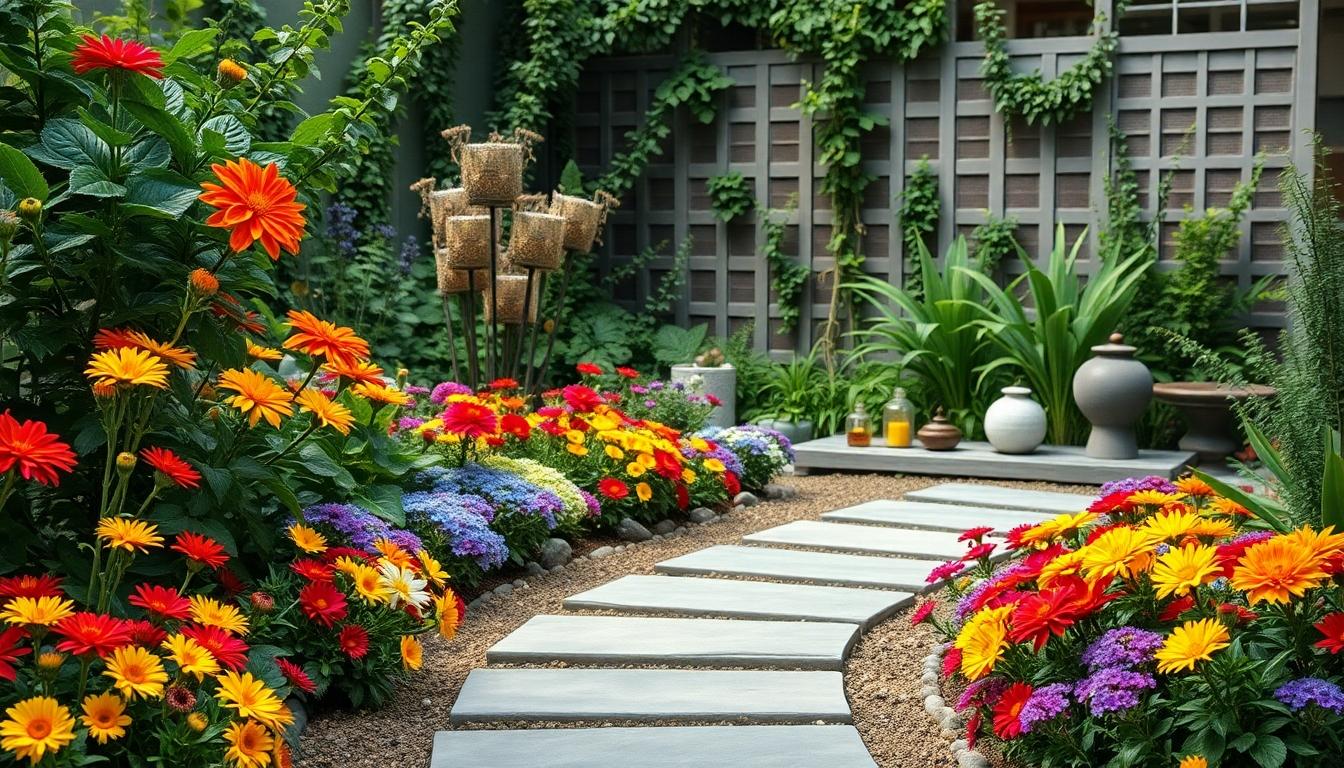
Colors play a powerful role in creating a harmonious and spiritually uplifting garden space. The thoughtful application of color theory can transform your garden into a sanctuary that evokes exact emotions and deepens your connection with nature.
Chakra-Based Garden Color Schemes
Chakra gardens represent one of the most meaningful ways to incorporate color theory into your spiritual outdoor space. These gardens use colors associated with the seven energy centers of the body, creating a complete spectrum that supports spiritual and emotional balance. Each chakra color adds unique energy to different areas of your garden:
- Red (Root Chakra) – Plant red flowers and use earth tones near the entrance to establish feelings of security and grounding.
- Orange (Sacral Chakra) – Include orange blooms in creative spaces or areas meant for artistic expression and emotional healing.
- Yellow (Solar Plexus Chakra) – Feature yellow flowers in sunny spots to boost confidence and personal power within your garden.
- Green (Heart Chakra) – Incorporate abundant greenery and green blossoms in central garden areas to promote love, compassion, and harmony.
- Blue (Throat Chakra) – Place blue flowers near meditation spots to enhance communication with yourself and the divine.
- Indigo (Third Eye Chakra) – Use indigo or purple-blue plants in quiet corners dedicated to intuition and inner wisdom.
- Violet (Crown Chakra) – Plant violet flowers in spaces designated for spiritual connection and higher consciousness work.
Monochromatic Gardens for Mindfulness
Monochromatic garden designs use variations of a single color to create a unified, peaceful environment that naturally encourages mindfulness. This approach minimizes visual distractions, allowing your mind to settle more easily during meditation or contemplative practices. Blue-themed gardens evoke particularly strong feelings of serenity and tranquility, making them ideal for dedicated meditation spaces.
Creating a monochromatic garden involves selecting plants that bloom in different shades of your chosen color throughout the seasons. Texture becomes especially important in these gardens, with varying leaf shapes and plant heights adding visual interest without breaking the calming color scheme. Consider complementing your plants with decorative elements that match or subtly enhance your chosen palette.
Our experience shows that monochromatic gardens work beautifully in smaller spaces where multiple colors might create visual overwhelm. They provide a focused environment where awareness can deepen naturally, turning your garden into a living meditation tool that supports your spiritual practice through simplicity and harmony.
Creating Seasonal Spiritual Garden Rituals

Aligning your garden activities with the natural cycles of the seasons can deepen your spiritual connection to the earth and enhance your garden’s sacred energy.
Spring Planting Ceremonies
Spring planting ceremonies establish powerful intentions for the growing season ahead. We recommend creating a ritual where you plant seeds or bulbs with exact intentions, such as hope, renewal, or peace. Begin by selecting plants that hold special meaning or symbolize your aspirations for the coming year. Before planting, hold each seed in your hands while meditating on your intention, infusing the seed with your energy and purpose. This practice transforms ordinary gardening into a sacred act of co-creation with nature. Many gardeners find that gathering friends or family for a collective planting ceremony amplifies the energy and creates a shared spiritual experience. These ceremonies serve as beautiful reminders of life’s cyclical nature and our connection to the renewal that spring represents.
Harvest and Gratitude Practices
Harvest rituals acknowledge the abundance your garden provides and cultivate a deeper sense of gratitude. Organize a special harvest ceremony to appreciate the fruits of your labor, expressing thankfulness for nature’s provision. We suggest creating a small altar in your garden where you can display some of your harvest as an offering of gratitude. Consider sharing your bounty with others as an extension of this practice, strengthening community bonds while honoring the garden’s gifts. A meaningful harvest ritual might include walking through your garden, mindfully selecting ripe produce or flowers, and saying words of appreciation for each item gathered. These practices help us recognize the nourishment—both physical and spiritual—that comes from tending a garden with love and intention.
Nighttime Spiritual Garden Features
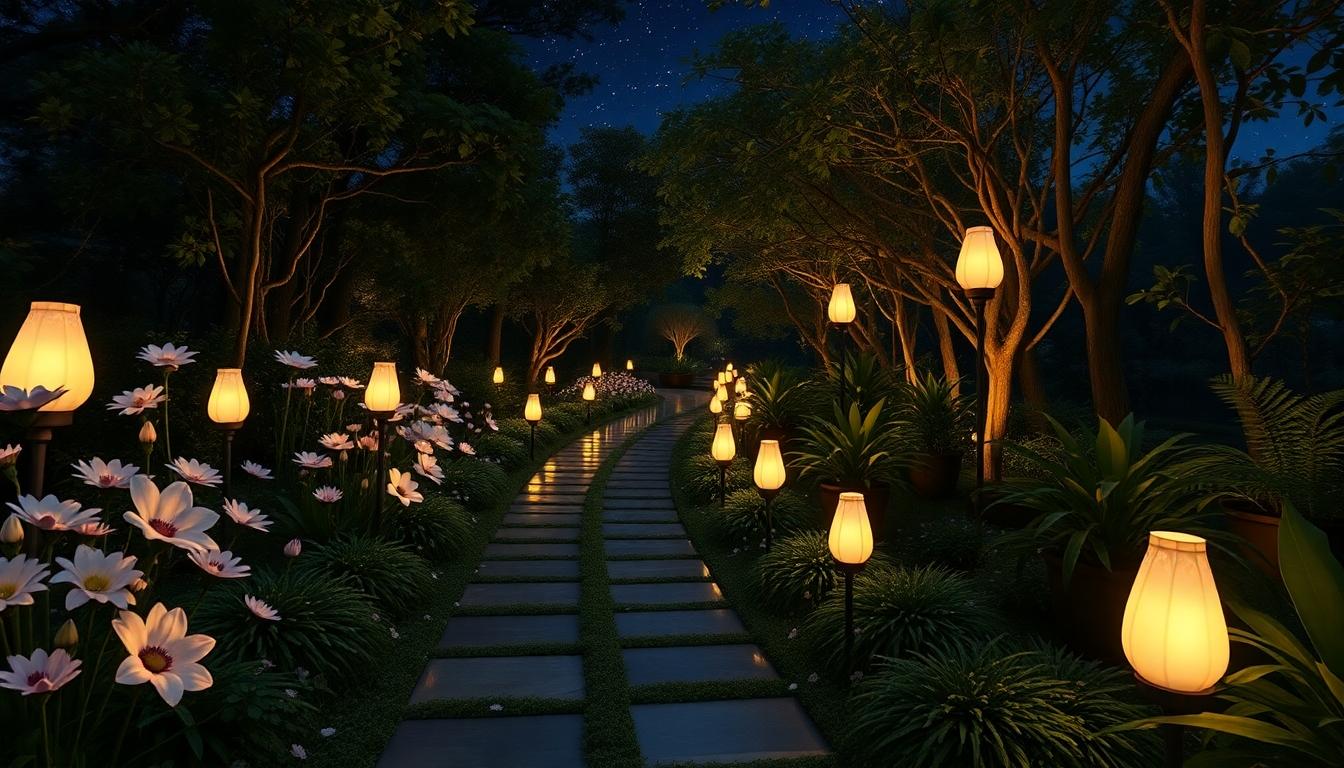
A spiritual garden can transform into a magical sanctuary after sunset, offering unique opportunities for reflection and connection with the cosmos. Creating intentional nighttime features enhances the garden’s spiritual dimension when darkness falls.
Moon Gardens with Night-Blooming Flowers
Moon gardens showcase white or pale-colored flowers that reflect moonlight, creating an ethereal glow that elevates nighttime spiritual practices. Evening primrose, moonflowers, and night-blooming jasmine are perfect choices for these luminous gardens, as they naturally open at dusk and emit subtle, enchanting fragrances. Their light-reflecting qualities create a natural illumination that guides meditation and quiet contemplation under the stars. We recommend planting these varieties in clusters where moonlight can easily reach them, maximizing their reflective properties while creating a sensory experience that engages both sight and smell during evening hours.
Sacred Lighting for Evening Meditation
Thoughtful lighting transforms a spiritual garden into a serene nighttime retreat without disrupting the natural darkness necessary for reflection. Soft LED lanterns placed along pathways provide gentle guidance without harsh brightness that might interfere with moongazing or stargazing practices. Solar-powered path lights offer sustainable illumination that automatically activates as darkness falls, requiring no maintenance during your meditation time. Flameless candles strategically positioned around meditation areas or water features create a flickering effect that mimics firelight without safety concerns. We find that lighting focused on key garden elements—such as statues, reflecting ponds, or special plants—creates focal points that anchor evening spiritual practices while maintaining the overall tranquility of the space.
Additional Nighttime Elements
Wind chimes introduce subtle soundscapes to your nighttime garden, signaling natural air movements and creating gentle audio reminders to stay present in your practice. Reflective surfaces, including small ponds or metallic garden ornaments, amplify available moonlight and create dancing patterns of illumination throughout the space. Sensory plants with evening fragrance, like lavender or chamomile, offer aromatherapeutic benefits that ground evening meditation sessions through their calming scents.
Our nighttime garden features prioritize elements that engage multiple senses while preserving the unique serenity that only comes after sunset. These thoughtful additions support various spiritual practices—from meditation to mindfulness—creating opportunities for deeper connection when the industry grows quiet and the boundary between the physical and spiritual seems most permeable.
Sustainable Practices for an Eco-Spiritual Garden
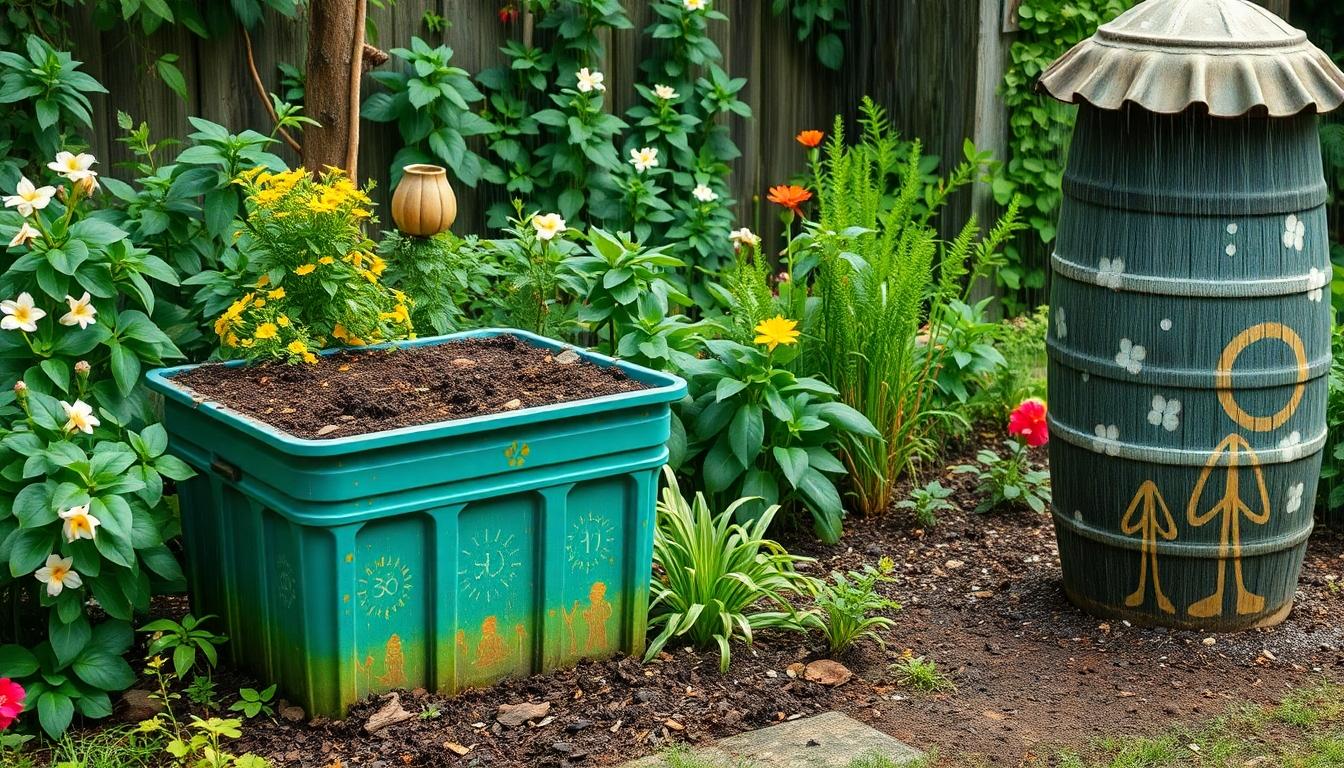
Creating an eco-spiritual garden involves practices that honor both the earth and our connection to it. These sustainable approaches transform ordinary gardening into meaningful spiritual acts that benefit both our souls and the planet.
Composting as a Spiritual Practice
Composting transcends mere waste management to become a powerful spiritual practice that connects us directly to nature’s cycles. This groundbreaking process reminds us of life’s continuous renewal as kitchen scraps and yard waste transform into rich, fertile soil. Gardeners who approach composting mindfully often report feeling a deeper connection to the earth’s regenerative powers. The decomposition process serves as a tangible metaphor for spiritual transformation—breaking down what no longer serves us to create something nurturing and new. By maintaining a compost system, we participate in a sacred cycle that turns death into life, waste into nourishment, and completes the circle of garden sustainability. This practice encourages us to reflect on impermanence while witnessing how endings inevitably lead to new beginnings.
Rainwater Collection Systems with Spiritual Significance
Rainwater collection embodies both practical sustainability and profound spiritual symbolism in the garden sanctuary. These systems honor water as a sacred element that sustains all life, creating a visible reminder of our dependence on natural resources. Decorative rain barrels can be adorned with spiritual symbols or mantras that celebrate water’s life-giving properties. The rhythmic sound of rain filling collection vessels provides a meditative soundtrack that enhances the garden’s contemplative atmosphere. Many spiritual gardeners create rituals around the first rainfall collection of the season, expressing gratitude for this precious resource. Water harvested from the sky carries special significance when used to nourish sacred or medicinal plants in the garden. By implementing these systems, we acknowledge the interconnectedness of all living things through the shared need for water. The practice teaches patience during dry periods and appreciation during abundance, mirroring important spiritual lessons about acceptance and gratitude.
Conclusion: Nurturing Your Spirit Through Garden Creation
Creating a spiritual garden isn’t just about arranging plants and decorative elements—it’s about crafting a living sanctuary that resonates with your soul. We’ve explored many ways to transform your outdoor space into a haven for meditation, reflection and spiritual growth.
Whether you’re drawn to Eastern or Western symbolism, chakra-based color schemes or moonlit sanctuaries, your spiritual garden can become an extension of your inner journey. The beauty lies in making it uniquely yours.
Remember that your garden will evolve just as you do. By tending to this sacred space with mindfulness and intention, you’re not just nurturing plants—you’re cultivating your spiritual practice and creating a personal retreat that will support your well-being for years to come.
Frequently Asked Questions
What is a spiritual garden?
A spiritual garden is a personal sanctuary designed for reconnecting with yourself and the universe. Unlike regular gardens, it intentionally incorporates elements that support meditation, reflection, and spiritual practice. These gardens have historical significance across various cultures and serve as spaces for finding inner peace and harmony with nature.
How do I choose the right location for my spiritual garden?
Select a location that feels peaceful and private. Look for a spot that receives appropriate sunlight for your chosen plants but also offers some shade for meditation. Consider natural features like trees or slopes that can be incorporated into your design. The ideal location should feel separate from busy household activities and provide a sense of sanctuary.
What plants are best for a spiritual garden?
Choose plants with spiritual significance or personal meaning. Herbs like lavender, sage, and rosemary offer both beauty and aromatherapy benefits. Roses symbolize love, while trees provide grounding energy. Native plants contribute to ecological harmony. Select species that resonate with your spiritual path and thrive in your climate to create a meaningful connection.
How can I incorporate meditation areas in my spiritual garden?
Create a dedicated space with comfortable seating like natural stone benches. Position it near water features for added tranquility. Consider Zen-inspired meditation circles with raked sand or minimalist designs. Add focal points such as Buddha statues or wind chimes to deepen your practice. Ensure the area feels private and protected for undisturbed reflection.
What water features work best in a spiritual garden?
Fountains, reflecting pools, and small ponds are excellent choices. Water features create soothing sounds that mask background noise and serve as meditation anchors. They symbolize renewal and self-reflection while attracting wildlife. Choose designs that match your garden’s scale and your maintenance capabilities. Even simple birdbaths can add meaningful water elements.
How can I use sacred geometry in my garden design?
Incorporate universal patterns like spirals, circles, and the flower of life into your layout. These patterns promote harmony and balance while adding symbolic meaning. Use them in pathway designs, plant arrangements, or decorative elements. Sacred geometry can be subtle or prominent depending on your preference, connecting your garden to ancient spiritual traditions.
What are prayer paths and labyrinths?
Prayer paths and labyrinths are walking meditation tools that encourage mindfulness and contemplation. Design pathways with materials like gravel or stepping stones to enhance sensory awareness. Create routes that promote slower movement, with aromatic plants alongside. A simple backyard labyrinth symbolizes life’s journey and provides a powerful meditation experience with its winding path to a central point.
How important are sound elements in a spiritual garden?
Sound elements create a multisensory experience essential for deeper meditation. Wind chimes and bells serve as mindfulness reminders and create calming tones with air movement. Water features provide soothing background sounds that facilitate meditation and mask unwanted noise. Strategic placement of these auditory elements transforms your garden into an immersive sanctuary for spiritual practice.
How can I use color in my spiritual garden design?
Utilize color theory to evoke specific emotions and enhance nature connection. Consider chakra-based color schemes where each hue corresponds to energy centers in the body. Alternatively, create monochromatic gardens using variations of one color for a peaceful, mindful environment. Focus on texture and seasonal blooms to maintain visual interest while fostering a calming atmosphere.
What are some spiritual garden rituals for different seasons?
Align gardening activities with natural cycles through seasonal rituals. Conduct spring planting ceremonies to establish intentions for the growing season. Perform harvest rituals to express gratitude for abundance. Create winter ceremonies honoring rest and renewal. These practices deepen your connection to nature’s rhythms and transform routine garden maintenance into meaningful spiritual practice.
How can I enhance my spiritual garden for nighttime use?
Create a moon garden with night-blooming flowers that reflect moonlight. Install soft LED lanterns or flameless candles for evening meditation. Add reflective surfaces like gazing balls or mirrors to amplify moonlight. Consider wind chimes for subtle nighttime sounds. These elements transform your garden into a magical sanctuary for nocturnal spiritual practices and reflection.
What sustainable practices complement a spiritual garden?
Implement composting as a spiritual practice connecting you to nature’s cycles of renewal. Install rainwater collection systems decorated with meaningful symbols as reminders of our dependence on natural resources. Choose organic gardening methods that honor all living beings. These eco-friendly approaches nurture both the earth and your spirit while reinforcing the interconnectedness of all life.

